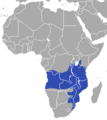Brown greater galago facts for kids
Quick facts for kids Brown greater galago |
|
|---|---|
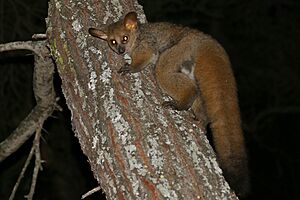 |
|
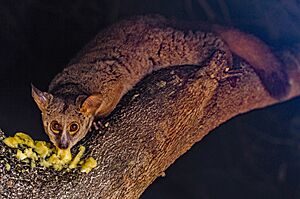 |
|
| Conservation status | |
| Scientific classification | |
| Genus: |
Otolemur
|
| Species: |
crassicaudatus
|
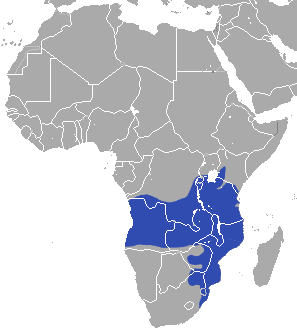 |
|
| Brown greater galago range | |
The brown greater galago is a fascinating animal. It's also called the large-eared greater galago or thick-tailed galago. This animal is a type of primate, like monkeys and apes. It's the biggest in the galago family! Unlike its smaller relatives, it prefers to climb, walk, or run instead of jumping around.
Contents
What is a Brown Greater Galago?
Galagos are small, night-active primates. The brown greater galago is the largest of them. They are known for their big eyes and ears. These animals live mostly in trees.
Different Types of Brown Greater Galagos
Scientists group animals into different types. For the brown greater galago, there are two main types, or subspecies:
- Otolemur crassicaudatus crassicaudatus
- Otolemur crassicaudatus kirkii
Some scientists also think the silvery greater galago might be a third type. However, others believe it's a separate species. All these types are considered "Least Concern" by conservation groups. This means they are not currently in danger of disappearing.
What Do They Look Like?
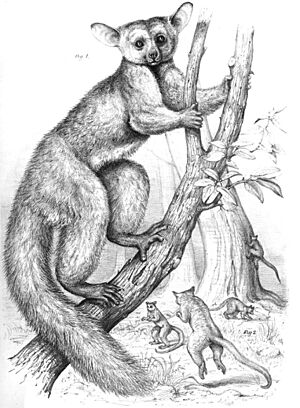
The brown greater galago has a round head. It has a short, wide nose area. Its ears are very large and can move on their own! Their eyes are also quite big and face forward. This helps them see well at night.
Their fingers and toes have flat, thick pads. These pads help them grip branches. Their fingers are long, and their toes are flat with flat nails.
Fur Color and Size
Their thick fur can be different colors. It depends on which type of galago it is:
- The O. c. crassicaudatus usually has fur that is buff (light brown) to gray. Its belly fur is cream-colored. Its tail often has a darker tip.
- The O. c. kirkii has fur that ranges from brown to gray on its back. Its belly fur is cream to yellow. Its tail is usually light brown.
Brown greater galagos are about 26 to 47 centimeters (10 to 18.5 inches) long, not including their tail. Their tail can be 29 to 55 centimeters (11 to 21.5 inches) long. They weigh between 0.5 and 2 kilograms (1 to 4.4 pounds).
Male galagos are usually bigger than females. This is because males grow for a longer time. On average, males weigh about 1.5 kg (3.3 lb). Females weigh about 1.2 kg (2.6 lb).
Where Do They Live?
This species is common in Southern and East Africa. You can find large groups in Angola, Tanzania, southern Kenya, and along the coast of Somalia.
Brown greater galagos live in tropical and subtropical forests. They especially like forests near rivers or coasts. They can also be found in woodland areas with scattered trees.
Specific Locations
Different types of galagos live in different places:
- The O. c. crassicaudatus is found only in the KwaZulu-Natal region of South Africa.
- The O. c. kirkii lives from Massangena north to Vila Coutinho, Mozambique, and Malawi.
How Do They Behave?
The brown greater galago is a night-active animal that lives in trees. During the day, it rests high up. It might hide in thick vines or inside a hollow tree. They rarely sleep on open branches. Female galagos build nests for their babies. These are leafy platforms with more leaves above for shelter.
Each galago might have several sleeping spots. At night, they come out to find food. They move on all fours through the trees. They can also make short jumps between trees if needed.
What Do They Eat?
Their diet includes many things:
- Fruits like berries and figs
- Seeds
- Acacia gum (a sticky substance from trees)
- Flowers
- Insects
- Slugs
- Even small reptiles and birds
A galago spends about half its night traveling. It spends only about 20% of its time looking for food. They often follow the same path every night. In zoos, galagos can live for 18 years or more. In the wild, they likely live shorter lives.
Social Life and Territory
These galagos are mostly solitary animals. They live in their own home areas, which can be a few hectares big. However, their areas can overlap with other galagos.
Male galagos have larger territories. Their areas might overlap with a few females. Female territories can also overlap with each other. But male territories usually do not overlap with other males.
Galagos mark their territory with urine. They also use a special scent from a gland on their chest. They usually interact with others where their territories meet. They also meet at places with lots of gum or good sleeping trees.
Young galagos, teenagers, and adult females with babies often play together. Unlike many other primates, they don't groom each other much. Instead, they lick each other's fur to keep clean.
Talking to Each Other
Vocal sounds are very important for galagos to communicate. Scientists have identified many types of calls:
- Loud cries
- Alarm calls for danger
- Calls to reject contact
- Distress calls
- Baby calls
- Mother calls
- Calls to attract a mate
Having Babies
During mating season, which is in June, females make a special call. This call lets males know they are ready to mate. Galagos can mate with one partner (monogamous) or multiple partners (polygynous). This often depends on how much their territories overlap.
Females usually give birth to two babies. Sometimes they have one or three. Pregnancy lasts about 133 days. Females are usually ready to have babies by two years old. Males often reach this age later because they compete for territories.
After birth, the mother leaves her babies to find food. She returns to feed them with her rich milk. The young galagos usually stay with their mother until they are almost grown up.
Are They in Danger?
The brown greater galago is listed as "Least Concern" by the International Union for Conservation of Nature (IUCN). This means they are not currently at high risk. They are thought to be common in protected areas.
The biggest threat to them is hunting for bushmeat (meat from wild animals). Their habitat is also being broken up into smaller pieces. This is happening because of things like sugar cane farms and forestry in South Africa.
Images for kids






